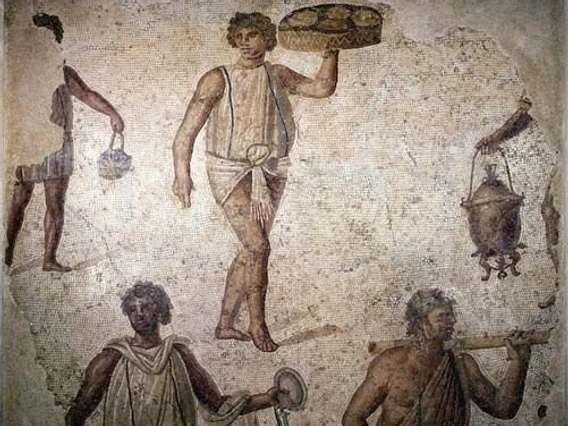Since the A Slave’s Story series is written from the vantage point of one of the characters in the story, I made a conscious effort to limit the narrative details to what he might reasonably have been able to see, hear, think, feel, and experience as the story progresses. Maintaining this character-centered perspective was challenging at times, since it meant not only avoiding scenes that lay beyond his observation (for example, what other people were thinking or what they were doing in his absence) but also omitting descriptions of things in his environment that might seem notable to us but were a normal part of the landscape to him (for example, people urinating in the street or touching the penis of a statue for good luck).
One of the more subtle problems with writing this way concerns how to talk about time. Our modern system of counting years from the supposed date of Jesus’ birth wasn’t devised until several centuries after the events in this story, and the use of a solar calendar of 12 months with 365 days is also a later development. The same is true for our lesser divisions of the day into 24 hours of 60 minutes and of minutes into 60 seconds.
The Roman calendar began with the year when Romulus, the mythical founder of Rome, was believed to have created the calendar (738 BC by modern reckoning). The events in this story take place in the mid-50s AD by Western calendars, which under the Roman system would have been the early 790s. Given this disparity, the only viable way to signal to my readers when the story was taking place was to refer in the opening chapter to the recent accession of Nero, who ruled from 54 to 68 AD.

Modern reconstruction of a Roman calendar
The Romans did use a twelve-month calendar similar to our own by the time of our story (in fact, we got our month names from them), but they didn’t number the days consecutively as we do (i.e., they couldn’t refer to “January 1st” or “March 10th”). Instead, they set aside three days of the month as anchor points for specifying dates. “Kalends” was the 1st day of the month, while “Ides” fell on the 13th or 15th (depending on the month) and “Nones” occurred between these two dates (8 days before Ides). Days were counted as so many days before or after one of these dates. Since this is the only system that my characters would have known, I use it throughout the novels, though I do recognize that it makes it harder for modern readers to follow the passing of time in the story.

Ancient Roman sundial, used to tell the hour of the day
The idea of a “week” of seven days was also unknown to the Romans, who instead divided time into eight-day market cycles. Days were subdivided into 24 hours, with 12 hours assigned to the daylight hours and 12 hours for night. Since the lengths of days and nights vary with the seasons, the length of a Roman hour also varied throughout the year, ranging from 45 minutes (by modern reckoning) in the winter to 75 minutes in the summer. The hours were numbered beginning at sunrise and again at sunset, so the “first hour” could mean either early morning or early evening. Where specificity was needed, the words “of the day” or “of the night” were added. Readers who encounter such references in my stories can convert them into modern times by using an educated guess for the time of sunrise or sunset in a particular season.
Lesser divisions of time below the hour were unknown–there were no “minutes” or “seconds” in the Roman system. Thus when I had occasion to refer to shorter units of time in the novels, my only option was to use phrases like “a few moments later,” “a short time earlier,” etc. The repetition of such phrases can grow tedious after a while, but they also help us to appreciate our ancestors who discovered the value of using “minutes” and “seconds” to denote time.
I certainly don’t expect my readers to remember all of this material, but those who have read this post will know where to look when they want answers!



